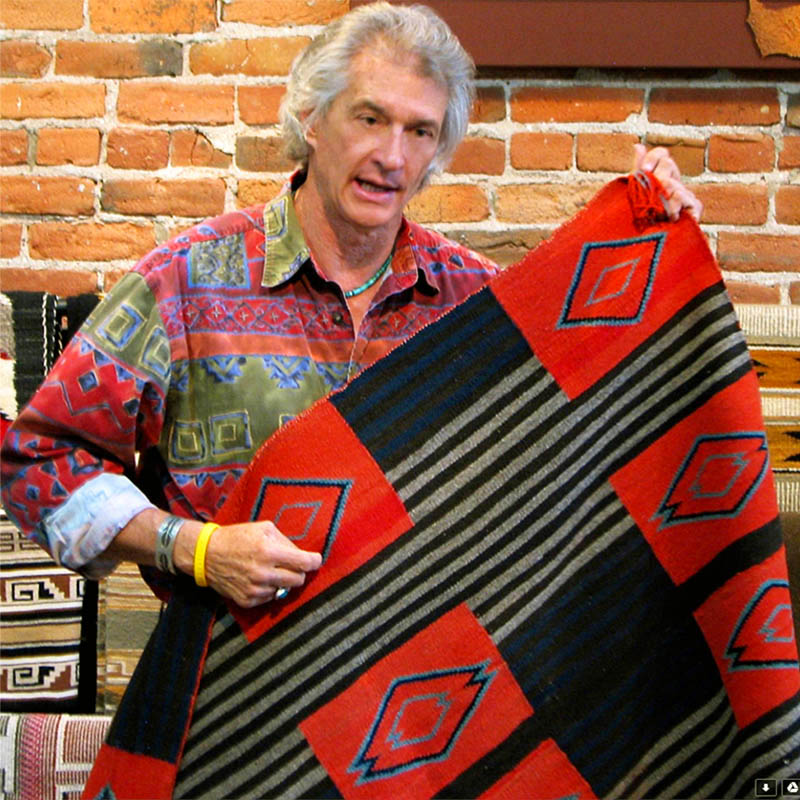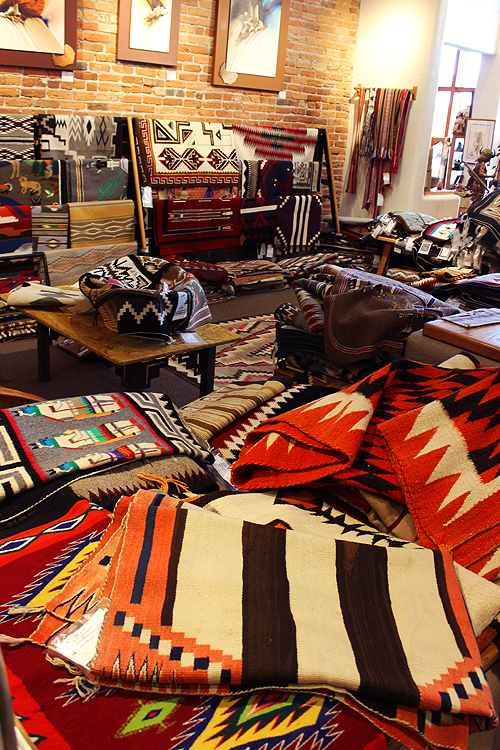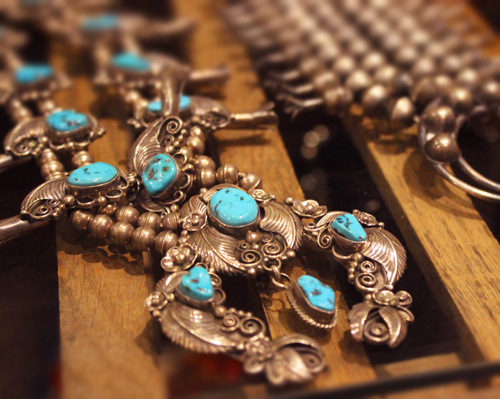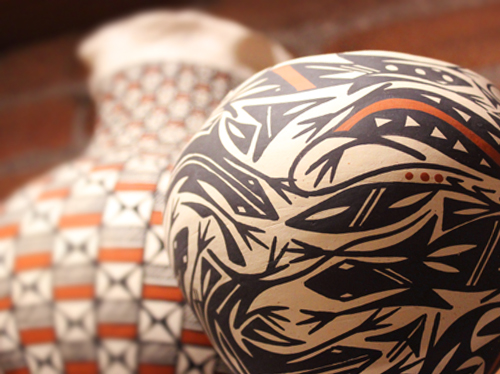
Jackson recalls his childhood of adventure as he traveled throughout the Southwest with his father, from trading post to reservation to meet the weavers, jewelry designers, ceramists, and painters, and bring their art back to Toh-Atin. He now carries on the business, along with his sister Antonia and mother Mary Jane. When you stand

Toh-Atin Gallery Weavings
in the gallery and talk with Jackson about the artwork, you will notice that he rarely if ever refers to notes. Because of his lifelong connection to Native American art and craftsmanship, he can easily identify the origin of a weaving, the individual dyes, and materials used to create it, the process of a ceramic pot and it’s glaze, the symbolism and significance of the artworks. And this is far beyond business for him, as he has a deep respect for the close relationships he is honored to have with the artists and their families.
We love to check our email and see that his newsletter has arrived, because he is a storyteller who shares personal accounts and memories of his life, the history and evolution of an artist’s vision, or the time he secretly entered an artist’s weaving in a national competition and her reaction to learn that she won first prize. Or the time he met with a master turquoise artist in a small town Walmart parking lot with many thousands of dollars worth of jewelry spread out on a grassy median as they spent the afternoon talking about life and in time came to an agreement on the sale. It’s all personal. And fascinating. He’s the guy you want to invite to your dinner parties. He’s the guy you wonder ‘how does he ever get any work done?’ because it’s such fun to drop by the gallery and chat with him for an hour or so. We are pleased to introduce an expert curator of Native American art, and one of the most authentic salt of the Earth people you could meet, Jackson Clark …
SWD GUEST Q&A:
SWD: Are you originally from the Southwest? If not, what brought you to the area?
Jackson: I was lucky enough to be born in Durango and smart enough to stay here. I am actually a fourth generation Durangatang.
SWD: Soft Tacos or Crunchy
Jackson: It’s more important what’s in the taco than what’s on the outside. It has to have a kick and I prefer shredded beef or chicken to ground beef. Tofu and textured vegetal protein does not belong in tacos.
SWD: What is your favorite adventure or getaway in the Southwest?
Jackson: Which kid is your favorite? Skiing, hiking, mountain climbing, bike riding, motorcycles, camping, fishing … if you are bored here, you deserve to be bored. My very favorite thing to do is to spend time on the Navajo reservation, visiting people, enjoying the landscape and the quiet. This is a very special and unique part of the world, steeped in spirituality and beauty. Nothing like it.
SWD: What is your favorite Southwestern National Park?
Jackson: There are some great National Monuments like Chimney Rock and National Parks like Arches, but I prefer Mesa Verde. It is the only National Park dedicated to the works of man rather than the works of nature.
SWD: Red or Green (or Christmas)?
Jackson: Nothing better than a good Green. Durango Diner’s green is hard to beat! I send jars of it out for Christmas presents.
SWD: What is the most satisfying aspect of what you do?
Jackson: Exposing people to the works and culture of Native Americans and in that way helping these incredible people have a better life. It’s great to love and appreciate someone’s work, but when you buy it, you buy their kids shoes and pay tuition bills and make it possible for Native people to enjoy the American lifestyle. There is a lot to be said for being able to afford a place to live, feed, clothe and support your family while being true to your cultural roots.
SWD: What is the most challenging aspect of what you do?
Jackson: Keeping the balance between modern life with its technology and maintaining that personal connection with our customers and artists. I think before cell phones and computers, we actually talked to each other and cared about each other more. It’s a slippery slope!
SWD: Corn or flour tortillas?
Jackson: Corn is better for you, flour works better with honey. Both have their place!
SWD: Do you cook? What do you love to make?
Jackson: I love to cook and I have discovered that all you have to do to be a cook is know how to read! Allrecipes.com is my favorite website. Something new every time, especially when you are having company. It’s like living on the edge!
 SWD: What do you absolutely refuse to eat?
SWD: What do you absolutely refuse to eat?
Jackson: Liver. The worst thing is to be at a party and pick up a toothpick that is stuck into something wrapped in bacon, thinking it is a pineapple or something, and hit liver!
SWD: This may have just been answered, but … What are your thoughts on menudo (and no, we don’t mean the boy band)?
Jackson: Every culture has it’s unique food items and this is one.
SWD: If you hypothetically moved away from the Southwest, what would you ask people to send to you in a care package? What would you miss the most about the Southwest?
Jackson: Not possible. I’d go to Walmart, get a gun and shoot myself first.
SWD: Is there a Southwest destination you’ve been wanting to visit?
Jackson: I have never been to Capital Reef. That is going to happen this year.
SWD: Do you have a mantra?
Jackson: “You can’t make this stuff up!”
###
Toh Atin Website and Jackson’s Blog
If you liked this SWD Q&A, you may also like:
SWD Article on Toh Atin Weavings
Q&A With A Master Ceramist and Clay Jewelry Artist

6 comments
Dear friends, here is the info on how to sign up for Toh-Atin’s newsletter:
People can sign up for our newsletter by going to our website at toh-atin.com and on the top right corner of the home page there is a box that they can put their email address in and they will start receiving the newsletter.
What type of blanket is Jackson holding in the photo? It’s beautiful!
Tara, we’re not sure … will get in touch with Jackson and find out!
Tara, we received this info from Jackson: The weaving I was holding is a Second Phase Chief’s Blanket design transitional.That basically means that the design is a slight variant of the Second Phase Blankets that were woven between 1850 and 1865, give of take. The design was used to create this blanket in the late 1800’s. The difference is primarily that it was woven with handspan wool using aniline dyes rather than Bayeta, which was actually cloth that was taken apart and re-spun to get the bright vibrant colors found in the early blankets. These commercial wools were dyed with cochineal and indigo (vegetal dyes) in eastern or European weaving mills. So this piece was woven between the day of the blankets and the time when the weavings were used on the floor—hence the term, “transitional”.
Jackson is a fascinating man. I would love to sit next to him at a dinner party and hear all of his stories! And I share his feelings on liver.
Ally, he’s a great guy with a wicked awesome sense of humor and love for life. The perfect person to sit next to at dinner, absolutely.